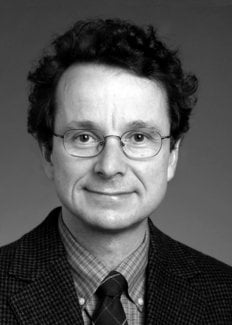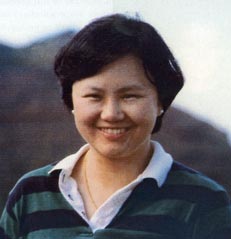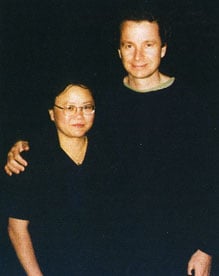Roderick MacKinnon
Biographical

I was born on February 19, 1956 in the middle of a snowstorm. It remains one of those humorous family stories that my mother likes to tell. My father the planner had rehearsed the way to the hospital but apparently things looked a lot different at night in a blizzard. Eventually they made it and so did I, the fourth of seven children. My father was a postal worker when I was very young but studied computers and became a programmer on the big IBM main frames. My mother worked as a part time schoolteacher, but mostly took care of the children at home. Thinking back on it now I know we did not have much money but I never knew that growing up. My parents provided a happy environment and made their expectations clear to us. Television is bad for you, reading is good for you, and you better get an A for effort in school. What you end up doing in life is up to you. Just make sure you enjoy what you do because then you will do it well. We all pursued completely different walks of life. I became the scientist.
I suppose there were some early indications of my tendency to a life of curiosity. Apparently from a very young age I had a habit of asking lots of questions: ‘what would happen if?’ was a favorite. And I liked having facts straight and knowing how things work and did not hesitate to give explanations to those around me, apparently to an annoying degree sometimes. I remember one day my father, at the end of his patience, commenting that I was a ‘compendium of useless information’. I certainly can understand his plight with one of the seven having way too many questions and answers all the time. On the positive side, I learned a new word that day when I looked up compendium in the dictionary.
There were probably even indications that my curiosity might be scientific. Burlington Massachusetts was rural when I was young and I loved to roam and explore. I had rock collections and read children’s books on geology and the history of the earth. I made little volcanoes out of plaster of paris and added baking soda and vinegar to the craters to simulate volcanic eruptions. I had an accident one day that made my mother laugh to my utter frustration: at that young age I failed to appreciate the humor in a little boy telling his mother he had dropped a volcano on his toe! In the summer I collected butterflies, turtles, snakes and other living things. One summer my mother enrolled me in a science enrichment class for elementary school students and I was allowed to take home a microscope. I used it to look at everything I could find: microorganisms from the nearby pond, leaves and blades of grass. I spent hour after hour alone, mesmerized by the tiny little things that I could see.
My scientific curiosity took a back seat to athletics through junior high and high school. Gymnastics was a good match to my small build and to my solitary nature. I was a member of a team but gymnastics is an individual sport. You learn a technique, then a ‘move’, and then a ‘routine’. And then you perfect it through practice, working mostly alone. I had a very good no nonsense teacher, coach Hayes, who really instilled in me the idea of perfection through practice. I was actually not all that bad, particularly at floor exercise and high bar. I even considered pursuing gymnastics in college, but during my final year of high school I began to wonder what I should pursue for a career.
I attended the University of Massachusetts in Boston for one year and then transferred to Brandeis University. Brandeis was an eye opening experience for me. For the first time in my life I was in a seriously intellectual environment. The classes tended to be small, intense, and stimulating. I discovered that I had a passion for science, and that I was very good at it. I chose Biochemistry as a major and a newly arrived assistant professor named Chris Miller for my honors thesis advisor. He had a little laboratory with big windows and lots of light shining in. I studied calcium transport and learned about the cell membrane as an electrode. I could see that Chris Miller was a man having lots of fun in his daily life and it was inspiring to me, and the memory of this stayed with me. But the biggest influence Brandeis had on my life happened in Physics class. There I met my future wife Alice Lee, whose sparkling eyes and sharp mind caught my attention.
Against Chris Miller’s advice I went to medical school after Brandeis. I studied at Tufts University School of Medicine and then at Beth Israel Hospital Boston for house officer training in Internal Medicine. I learned a lot but in the end I should have taken Chris’ advice to pursue science. Medicine required a lot of memorization and little analytical problem solving. To keep a certain part of my brain active I began to study mathematics, and continue this even today, learning new methods and solving problems with the same disciplined approach I had learned in gymnastics. I started back to science near the end of house officer training working with Jim Morgan studying calcium in cardiac muscle contractility, which was very enjoyable and kept me connected to medicine. But I had a yearning to work on a very basic science problem, which meant I would have to break my medical ties. This was a difficult decision because I had invested so many years in medical education; to abandon it was to admit to myself that I had misspent a big piece of my life. And there were practical considerations as well. It was time finally to get a permanent job; after all, my wife Alice had supported me through years of training. Not to mention I was nearly 30 years old with no real basic science training beyond my Brandeis undergraduate education: would I even be able to make it as a scientist?
 Alice Lee in 1986 at the time of my decision to leave medicine for science.
Alice Lee in 1986 at the time of my decision to leave medicine for science.
Two factors had the greatest influence on my decision. Back in my first year of medical school I lost my sister Elley, an artist only two years my senior. Diagnosed with leukemia during my hematology clerkship as I learned about the dreaded disease, she lasted only two months. This horrifying event impressed upon me how fragile and precious life is, and how important it is to seize the moment and enjoy what you do while you can. I remember thinking when I look back upon my life at the age of seventy, thirty will seem young: just go for it. And the second factor was Alice. She had complete faith in my ability to succeed. Never mind that postdoctoral studies meant a reduction of my already piddling house officer salary. She simply said you have no choice; we will manage somehow.
Memories of Chris Miller’s laboratory beckoned so I returned for postdoctoral studies. Of course I will never out live his reminding me that I should have listened to him in the first place. Feeling far behind in my knowledge I approached my postdoctoral studies with intensity, learning techniques and theory. I felt I should be an expert in electrochemistry, stochastic processes, linear systems theory, and many more subjects. I read books, solved the problem sets, mastered the subjects, and carried out experiments. I had the very good fortune of a coworker Jacques Neyton, a postdoctoral scientist from France. Jacques is a very critical thinker who would brood on a problem. We exchanged ideas often. When I would tell him one of my ideas he had a tendency just to listen quietly. Then, after a while, if his response started with ‘Hey Roddy, there’s something I don’t understand’ I knew I was in trouble – my idea was probably no good!
After I completed a series of biophysical studies on K+ channels it came time to apply for an academic position. During the late 1980s physiology departments were more interested in hiring channel gene cloners than bio-physicists. But Peter Hess convinced his colleagues at Harvard that my work showed promise and I was offered an assistant professorship there. My laboratory made good progress on K+ channels. It was exciting for a while but in just a few years I began to feel that the return on what we could learn from studying the functional effects of mutations was diminishing. We had identified the K+ channel signature sequence, but without knowing its structure we never would understand the chemical principles of ion selectivity in K+ channels. I decided at that point to learn X-ray crystallography to someday see a K+ channel.

I began to learn methods of protein purification and X-ray crystallography while still at Harvard, initially working with channel toxins and a small soluble protein called a PDZ domain. However, I thought it best to move away from my familiar environment at Harvard to pursue channel structure. There were really two reasons motivating me to move. First was the practical issue of obtaining funding to work in an area in which I had no background: start-up funds associated with moving to a new university would be useful for this purpose. The second and far more important reason was that moving would enable me to immerse myself completely in the new endeavor. A change of environment would remove the distractions of everyday life, isolate me from the temptation to fall back on channel physiology studies that I was already good at, and allow me to focus with singular purpose on the structural studies. I needed this to become an expert in membrane protein biochemistry and X-ray crystallography, and to develop a ‘feel’ for protein structure. When the president of Rockefeller University Torsten Wiesel heard about my scientific plans he suggested that I move to Rockefeller University and I did. Rockefeller provided a wonderful environment for concentrating on a difficult problem.
It has been said that giving up my already successful lab at Harvard in order to pursue the structure of a K+ channel was a risky thing to do. At the time I was told that my aspirations were altogether unrealistic. From my perspective I had little choice because I wanted to understand K+ selectivity and I knew that the atomic structure provided the only path to understanding. I would rather fail trying than never try at all. It helped that I was accustomed to making transitions and had become good at teaching myself new subjects. I have to admit that few people working with me at the time wanted much to do with the new endeavor – only one new postdoctoral scientist Declan Doyle was enthusiastic. My wife Alice, an organic chemist, saw that I was going to be pretty lonely and decided to join me in the lab. And to my good fortune she has worked with me since. I have learned that most people do not like change but I do. For me change is challenging, good for creativity, and it definitely keeps life interesting.
I think of the past eight years of my life in New York at Rockefeller University as a personal odyssey. The new laboratory started out very small, with only Declan, Alice and me. But it grew in the first year with the addition of other enthusiastic postdoctoral scientists, including João Morais Cabral and John Imredy. Working with membrane proteins was very difficult as expected. We had our periods of despair, but every time we felt left without options something good happened and despair gave way to excitement. Persistence and dedication eventually paid off. The atomic structure of the K+ selectivity filter was more informative and more beautiful than I ever could have imagined. My laboratory now is an incredible place, overflowing with excitement and ideas sustained by the continual infusion of bright young scientists who come from around the world to work with me. It gives me great satisfaction to know that these young scientists who are sophisticated in their knowledge of protein chemistry and structure will lead the field of ion channel research into the future. This has been a wonderful adventure. I owe thanks for the life I have: to Alice, to all my loving family of MacKinnons and Lees, to my scientific family of students, postdocs and colleagues, to senior colleagues who have helped me along my way to pursue my passion, and to the Rockefeller University, the Howard Hughes Medical Institute, and the National Institutes of Health for their support. I am very thankful for my life as a scientist, for the opportunity to understand in some small way the world around me. I hope my best experiment and scientific ideas are yet to come. This hope keeps me going.
This autobiography/biography was written at the time of the award and later published in the book series Les Prix Nobel/ Nobel Lectures/The Nobel Prizes. The information is sometimes updated with an addendum submitted by the Laureate.
Nobel Prizes and laureates
Six prizes were awarded for achievements that have conferred the greatest benefit to humankind. The 14 laureates' work and discoveries range from quantum tunnelling to promoting democratic rights.
See them all presented here.
